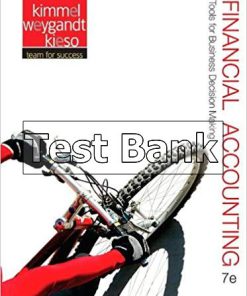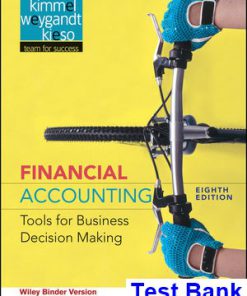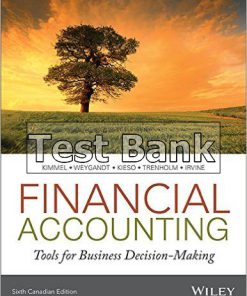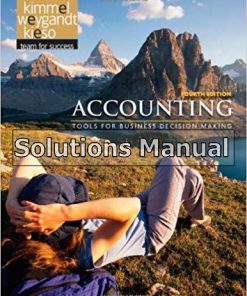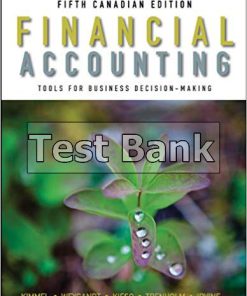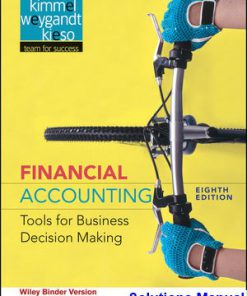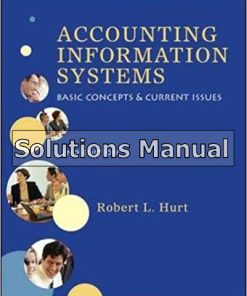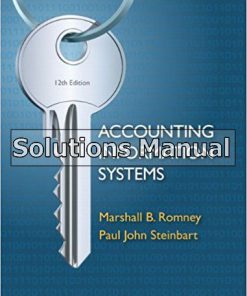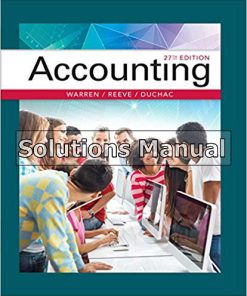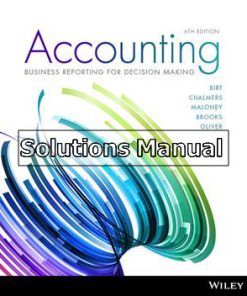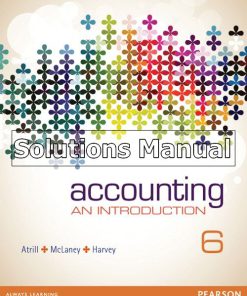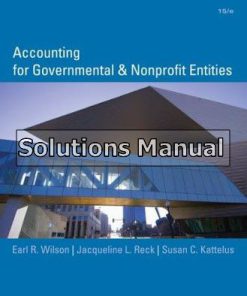Financial Accounting Tools for Business Decision-Making Canadian 7th Edition Kimmel Solutions Manual
$26.50$50.00 (-47%)
Financial Accounting Tools for Business Decision-Making Canadian 7th Edition Kimmel Solutions Manual.
You may also like
Financial Accounting Tools for Business Decision-Making Canadian 7th Edition Kimmel Solutions Manual
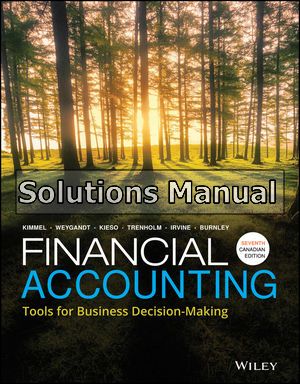
Product details:
- ISBN-10 : 1119368456
- ISBN-13 : 978-1119368458
- Author: Paul D. Kimmel (Author), Jerry J. Weygandt (Author), Donald E. Kieso (Author), Barbara Trenholm (Author), Wayne Irvine (Author), Christopher D. Burnley (Author)
The new seventh edition of Financial Accounting: Tools for Decision-Making by Kimmel, Weygandt, Kieso, Trenholm, Irvine and Burnley continues to provide the best tools for both instructors and students to succeed in their introductory financial accounting class. It helps students understand the purpose and use of financial accounting, whether they plan to become accountants or whether they simply need it for their personal life or career. The book’s unique, balanced procedural and conceptual (user-oriented) approach, proven pedagogy and breadth of problem material has made Financial Accounting the most popular introductory text in Canada. This hands-on text, paired with a powerful online teaching and learning environment, WileyPLUS with ORION, offers students a practical set of tools for use in making business decisions based on financial information.
Financial Accounting Tools for Business Decision-Making Canadian 7th Edition Kimmel Test Bank
Table contents:
Cover
Title Page
Copyright
About the Authors
What’s New?
Active Teaching And Learning Supplementary Material
Acknowledgements
1 The Purpose and Use of Financial Statements
LO 1: Identify the uses and users of accounting information.
LO 2: Describe the primary forms of business organization.
LO 3: Explain the three main types of business activity.
LO 4: Describe the purpose and content of each of the financial statements.
2 A Further Look at Financial Statements
LO 1: Identify the sections of a classified statement of financial position.
LO 2: Identify and calculate ratios for analyzing a company’s liquidity, solvency, and profitability.
LO 3: Describe the framework for the preparation and presentation of financial statements.
3 The Accounting Information System
LO 1: Analyze the effect of transactions on the accounting equation.
LO 2: Explain how accounts, debits, and credits are used to record transactions.
LO 3: Journalize transactions in the general journal.
LO 4: Post transactions to the general ledger.
LO 5: Prepare a trial balance.
4 Accrual Accounting Concepts
LO 1: Explain the accrual basis of accounting and the reasons for adjusting entries.
LO 2: Prepare adjusting entries for prepayments.
LO 3: Prepare adjusting entries for accruals.
LO 4: Prepare an adjusted trial balance and financial statements.
LO 5: Prepare closing entries and a post-closing trial balance.
5 Merchandising Operations
LO 1: Identify the differences between service and merchandising companies.
LO 2: Prepare entries for purchases under a perpetual inventory system.
LO 3: Prepare entries for sales under a perpetual inventory system.
LO 4: Prepare a single-step and a multiple-step income statement.
LO 5: Calculate the gross profit margin and profit margin.
LO 6: Appendix 5A: Account for and report inventory in a periodic inventory system.
6 Reporting and Analyzing Inventory
LO 1: Describe the steps in determining inventory quantities.
LO 2: Apply the cost formulas using specific identification, FIFO, and average cost under a perpetual inventory system.
LO 3: Explain the effects on the financial statements of choosing each of the inventory cost formulas.
LO 4: Identify the effects of inventory errors on the financial statements.
LO 5: Demonstrate the presentation and analysis of inventory.
LO 6: Appendix 6A: Apply the FIFO and average cost formulas under a periodic inventory system.
7 Internal Control and Cash
LO 1: Explain the components of an internal control system, including its control activities and limitations.
LO 2: Apply the key control activities to cash receipts and payments.
LO 3: Prepare a bank reconciliation.
LO 4: Explain the reporting and management of cash
8 Reporting and Analyzing Receivables
LO 1: Identify the types of receivables and record accounts receivable transactions.
LO 2: Account for bad debts.
LO 3: Account for notes receivable.
LO 4: Explain the statement presentation of receivables.
LO 5: Apply the principles of sound accounts receivable management.
9 Reporting and Analyzing Long-Lived Assets
LO 1: Determine the cost of property, plant, and equipment.
LO 2: Explain and calculate depreciation.
LO 3: Account for the derecognition of property, plant, and equipment.
LO 4: Identify the basic accounting issues for intangible assets and goodwill.
LO 5: Illustrate how long-lived assets are reported in the financial statements.
LO 6: Describe the methods for evaluating the use of assets.
10 Reporting and Analyzing Liabilities
LO 1: Account for current liabilities.
LO 2: Account for instalment notes payable.
LO 3: Identify the requirements for the financial statement presentation and analysis of liabilities.
LO 4: Appendix 10A: Account for bonds payable.
11 Reporting and Analyzing Shareholders’ Equity
LO 1: Identify and discuss the major characteristics of a corporation.
LO 2: Record share transactions.
LO 3: Prepare the entries for cash dividends, stock dividends, and stock splits, and understand their financial impact.
LO 4: Indicate how shareholders’ equity is presented in the financial statements.
LO 5: Evaluate dividend and earnings performance.
12 Reporting and Analyzing Investments
LO 1: Identify reasons to invest, and classify investments.
LO 2: Account for non-strategic investments.
LO 3: Account for strategic investments.
LO 4: Explain how investments are reported in the financial statements.
LO 5: Appendix 12A: Compare the accounting for a bond investment and a bond payable.
13 Statement of Cash Flows
LO 1: Describe the content and format of the statement of cash flows.
LO 2: Prepare the operating activities section of a statement of cash flows using the indirect method.
LO 3: Prepare the investing and financing activities sections and complete the statement of cash flows.
LO 4: Use the statement of cash flows to evaluate a company.
LO 5: Appendix 13A: Prepare the operating activities section of a statement of cash flows using the direct method.
14 Performance Measurement
LO 1: Explain and apply comparative analysis.
LO 2: Calculate and interpret ratios that are used to analyze liquidity.
LO 3: Calculate and interpret ratios that are used to analyze solvency.
LO 4: Calculate and interpret ratios that are used to analyze profitability.
LO 5: Understand the limitations of financial analysis.
Appendix A Specimen Financial Statements: The North West Company Inc.
Appendix B Specimen Financial Statements: Sobeys Inc.
Glossary
Company Index
Subject Index
EULA
People also search:
financial Accounting Tools for Business Decision-Making Canadian 7th
accounting tools for decision making
financial accounting tools for business decision-making eighth canadian edition
managerial accounting tools for business decision making
tools for business decision making
wiley financial accounting tools for business decision making

